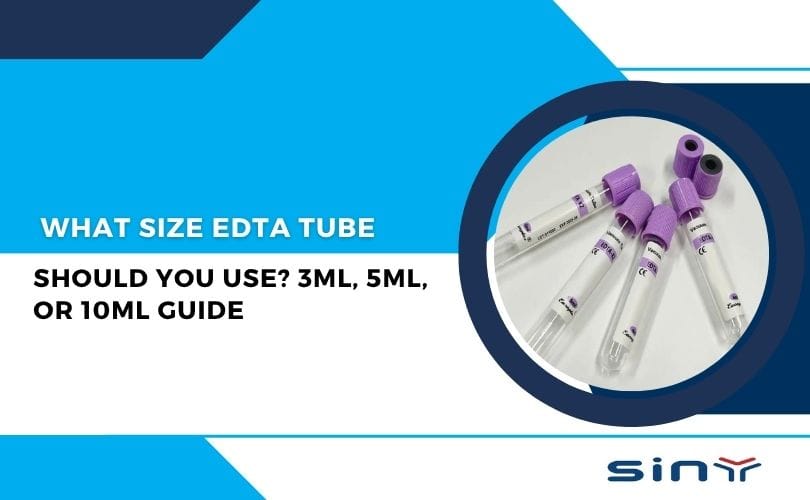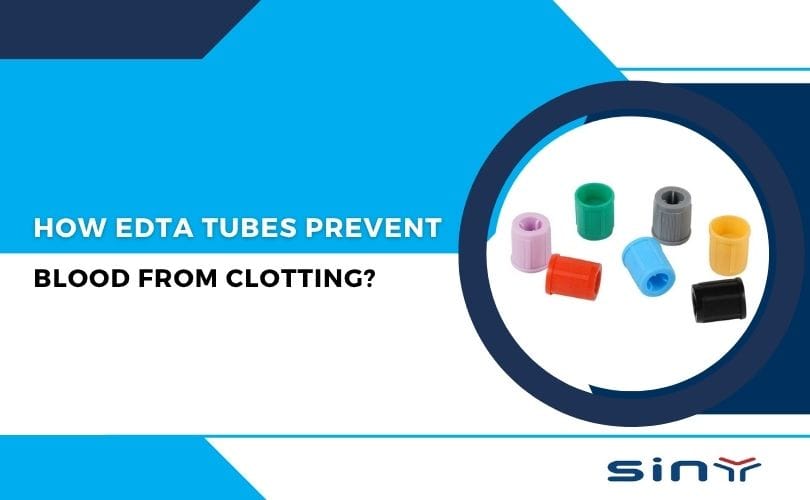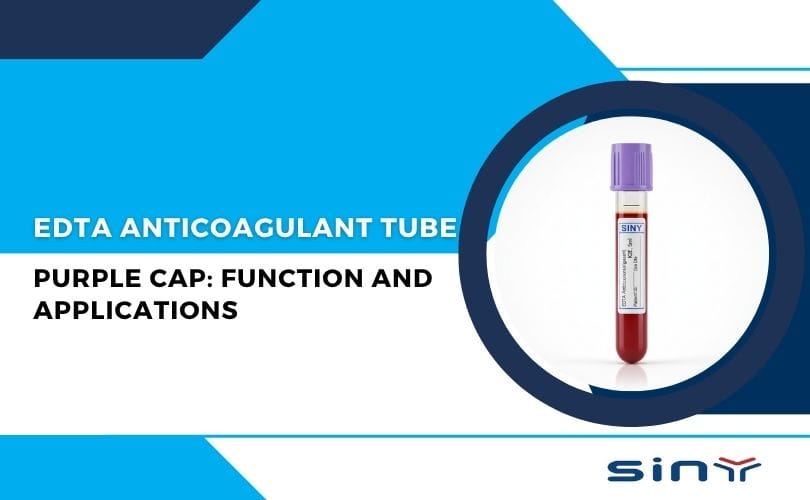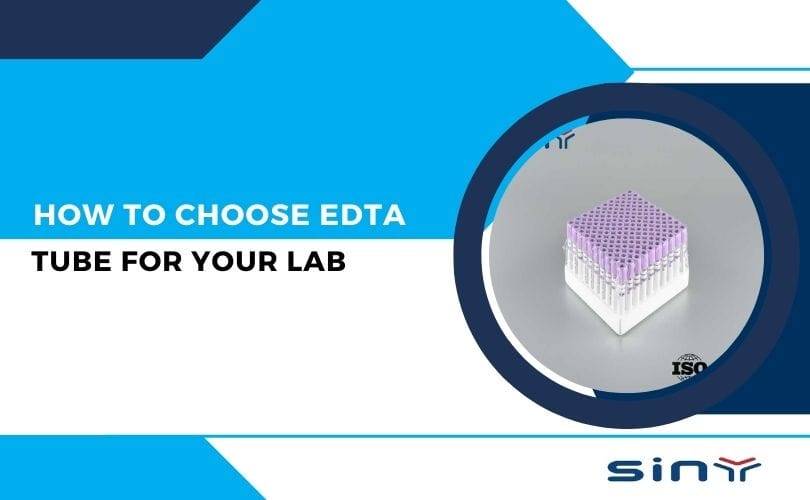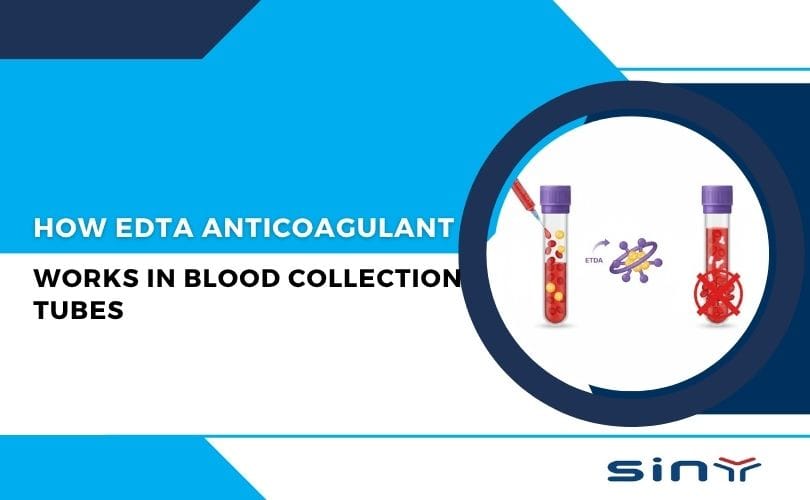The EDTA tube is the indispensable purple-capped workhorse of the clinical hematology laboratory. Every single Complete Blood Count (CBC), blood typing, and HbA1c test hinges on the successful collection of whole blood into a tube containing the potent anticoagulant, Ethylenediaminetetraacetic acid. While the chemistry of EDTA remains constant, the physical dimensions of the tube—specifically its capacity—vary significantly, creating a crucial decision point for phlebotomists and commercial buyers: What size EDTA tube should you use?
Choosing the correct size EDTA tube (3ml, 5ml, 10ml, or others) is not a matter of convenience; it is a critical pre-analytical factor that directly impacts specimen integrity, testing accuracy, and patient safety. An underfilled large tube or an inappropriately selected small tube can render a sample useless, leading to recollection, delayed diagnosis, and increased costs.
For laboratories, hospitals, and commercial entities sourcing large volumes of EDTA tubes for blood collection, understanding the functional differences between the available sizes is paramount to efficient procurement and workflow management. edtatube.com provides a wide range of sizes, including the popular 3ml, 4ml, 5ml, and 10ml sterile sample vacuum EDTA K3/K2 blood collection test tubes, ensuring every specific requirement is met with precision and quality.
Why Does Tube Size Matter?
The size of the EDTA tube you choose depends on the type of test being performed and the volume of blood required. Using the wrong size can lead to inaccurate results or the need for a second blood draw, which can be inconvenient for both the patient and the healthcare provider.
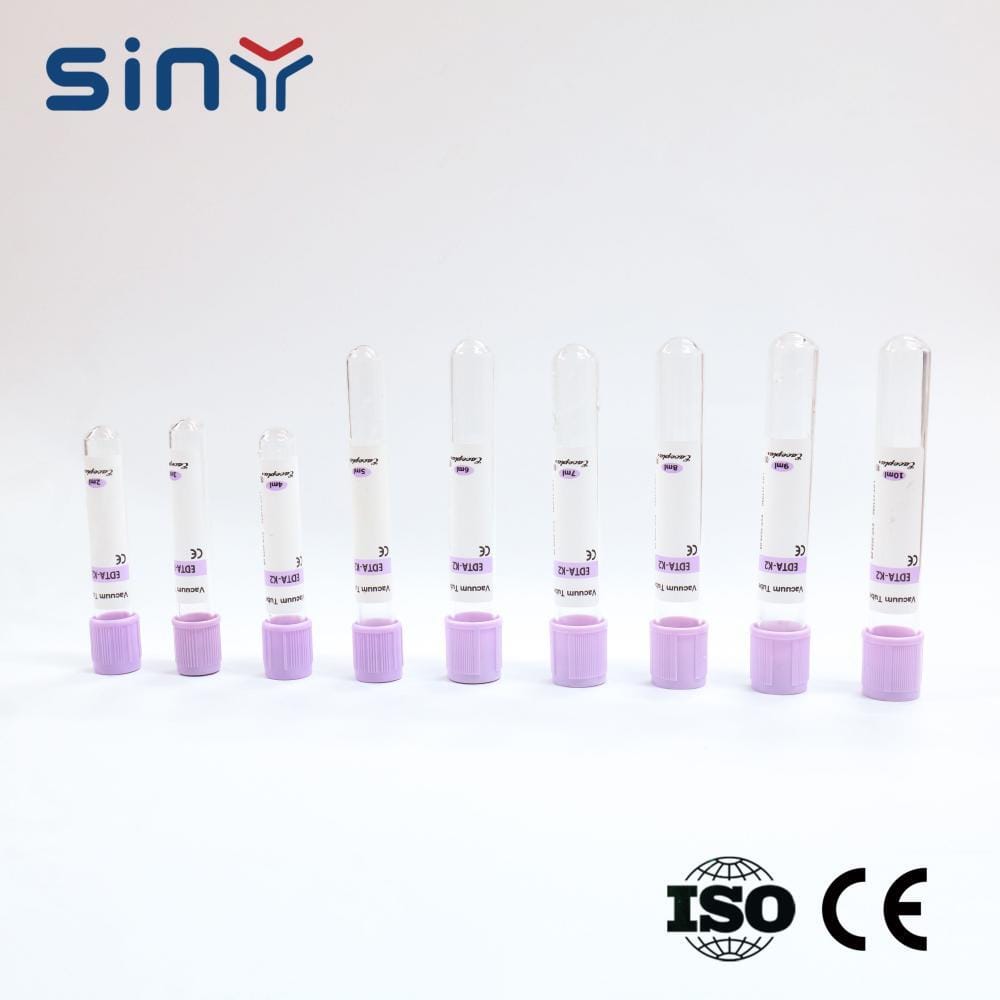
Key factors to consider when choosing a tube size:
- Test Requirements: Some tests require a specific volume of blood to ensure accurate results.
- Patient Comfort: Larger tubes may require more blood, which can be uncomfortable for some patients.
- Lab Efficiency: Using the right size tube can streamline the testing process and reduce waste.
The Scientific Imperative: Why Size and Fill Volume are Non-Negotiable
The fundamental rule governing the use of the EDTA tube is the accurate blood-to-anticoagulant ratio. EDTA is coated or spray-dried onto the interior wall of the tube in a precise concentration to fully anticoagulate a specific volume of blood. This ratio is typically 1.5 to 2.2 mg of EDTA per 1.0 ml of blood.
The Dangers of an Incorrect Ratio
Selecting the wrong Size EDTA Tube relative to the amount of blood collected, or failing to fill any tube to its designated line, introduces critical errors:
Over-Concentration (Underfilling): If a large tube (e.g., a 10ml tube) is only half-filled, the concentration of EDTA relative to the blood volume is too high. This excess EDTA has an osmotic effect, drawing water out of the red blood cells.
- Result: The red blood cells shrink, leading to an artificially low Mean Corpuscular Volume (MCV) and Hematocrit (Hct). This can lead to a misdiagnosis of microcytic anemia.
Under-Concentration (Overfilling): If a tube is filled beyond its vacuum limit, the concentration of EDTA is too low.
- Result: The sample is inadequately anticoagulated, allowing the formation of micro-clots. These small clots consume platelets, leading to pseudothrombocytopenia (falsely low platelet count), a common pre-analytical error.
Therefore, the selected tube size must be one that allows the phlebotomist to easily obtain a blood volume that accurately reaches the tube’s fill line.
The Spectrum of EDTA Tube Sizes: 3ml, 5ml, and 10ml
The EDTA tube market offers various capacities to accommodate different testing needs and patient profiles. The choice of tube size is directly correlated with the anticipated volume of blood required by the lab.
The Small Capacity Tube: The 3ml EDTA Tube
The 3ml EDTA Tube (and similar smaller sizes like 2ml or 4ml) serves a highly specific and crucial function in blood collection.
Primary Applications and Advantages:
- Pediatric and Geriatric Use: This size is ideal for patients with small or fragile veins, such as infants, children, or elderly patients, where limiting total blood draw volume is essential. Minimizing the draw volume reduces the risk of iatrogenic anemia.
- Targeted Testing: It is perfectly suited when only a single test, like a routine CBC or a single EDTA vacuum blood collection tube for HbA1c test, is ordered.
- Minimizing Waste: Using a smaller tube when minimal blood is needed ensures efficient use of consumables and minimizes the ethical challenge of over-collecting blood.
Considerations:
- Risk of Clotting: Due to the small bore and reduced surface area for the additive, inadequate mixing is highly likely to cause clotting in a small sample. Gentle, immediate, and thorough inversion is critical.
- Limited Tests: A 3ml tube is typically only enough for a CBC and potentially a differential, limiting its utility for extensive test panels.
The Standard Capacity Tube: The 5ml EDTA Tube
The 5ml EDTA Tube is often considered the standard or “workhorse” size for adult phlebotomy in many clinical settings globally.
Primary Applications and Advantages:
- Routine Adult Testing: This size offers the perfect balance, providing enough whole blood to run a complete battery of hematology tests, including CBC, differential, retic count, and blood typing, with sufficient volume leftover for quality control and potential repeats.
- Optimal Handling: It is large enough to ensure even distribution of the EDTA additive upon mixing, reducing the risk of micro-clots, yet small enough to be easily managed in automation racks.
- Versatility: The 5ml capacity is a safe choice for most adult outpatient draws where multiple hematology-related tests are requested simultaneously.
Considerations:
- Fill Integrity: Though standard, the integrity of the 5ml sample still relies heavily on the phlebotomist ensuring the tube is filled to the vacuum line. A half-full 5ml tube is still an improperly collected specimen.
The High Capacity Tube: The 10ml EDTA Tube
The 10ml EDTA Tube represents the largest standard vacuum draw volume and is reserved for situations demanding a large volume of whole blood.
Primary Applications and Advantages:
- Specialized Testing: It is essential for specific, high-volume molecular diagnostics, large-scale genetics studies, and certain research protocols that require an exceptional amount of cellular material (e.g., DNA/RNA extraction).
- Batch Testing: In large reference labs, a 10ml tube might be used to provide enough whole blood for multiple high-throughput tests to be run over several days, requiring greater sample stability and volume.
- Blood Banking: While pink-cap tubes (often 7ml or 10ml) are used specifically for blood bank cross-matching, the underlying need is high volume for extensive testing.
Considerations:
- High Risk for Underfilling: If the phlebotomist cannot obtain the full 10ml, the remaining blood will be highly over-anticoagulated, making the sample unusable for most hematology analyses due to red cell shrinkage.
- Avoidance in Routine Draws: The 10ml tube should be strictly avoided for routine CBCs unless a very large volume is explicitly required, as it increases the risk of iatrogenic anemia and sample wastage.
Influencing the Selection of the Ideal Size EDTA Tube
The choice of the Size EDTA Tube must be systematized, usually by laboratory protocols, to standardize pre-analytical quality.
The Laboratory Test Requisition
The single greatest determinant of tube size is the number and type of tests ordered.
- Minimum Volume Requirement: Each diagnostic analyzer (e.g., CBC analyzer) requires a specific minimum volume of blood to run its test panel. Typically, a CBC requires only 0.5 to 1.0ml of blood, but the tube must be filled higher to ensure a proper ratio and to allow the analyzer probe to sample from the correctly mixed whole blood layer.
- Repeat and Add-on Capacity: Professional practice dictates that the initial tube size should allow for enough blood volume to run the test plus have enough reserve for potential technical repeats or for the possibility of a clinician adding another related test (an “add-on”) later that day. For a routine CBC, this typically drives the use toward a 5ml tube rather than a 3ml one.
Patient Demographics and Clinical Condition
The patient population dictates when smaller tubes become a necessity rather than an option.
| Patient Group | Recommended Tube Size Strategy | Rationale |
| Neonates/Infants | Smallest available micro-collection or 0.5-1.5ml tubes. | Preventing iatrogenic anemia (blood loss resulting from frequent sampling). |
| Pediatric | 2ml to 3ml EDTA tubes for blood collection. | Less traumatic draw, and total blood volume is conserved. |
| Geriatric/Oncology | 3ml to 5ml, avoiding 10ml size. | Fragile veins, potential for severe anemia, or low tolerance for large volume draws. |
| Routine Adult | Standard 5ml EDTA Tube. | Sufficient volume for comprehensive testing and repeats. |
Equipment Compatibility
Modern clinical laboratories rely heavily on automation. The selected tube size must be compatible with the automated equipment used for processing.
- Tube Dimensions: Tube diameter and length must fit the racks, centrifuges, and analyzers. Standard 13x75mm or 13x100mm tubes are used, but the fill volume (e.g., 3ml vs. 5ml) changes based on the vacuum and label design, not always the physical tube dimensions themselves.
- Automated Labeling: Commercial buyers sourcing lavender cap EDTA K2 vacuum blood collection tube products must ensure their chosen tube dimensions are compatible with automated labeling and conveyance systems in the clinical lab.
Procurement Perspective: Commercial Considerations for EDTA Tube Sizing
For commercial buyers representing hospitals or large diagnostic networks, the selection of the primary EDTA tube size has significant logistical and financial implications.
The Case for Standardization and Bulk Purchase
Standardizing on one primary size, such as the 5ml EDTA Tube, simplifies inventory management, streamlines staff training, and leverages cost savings through bulk purchases. If a facility determines that 80% of its hematology tests can be adequately covered by a 5ml EDTA Tube, it makes economic sense to focus procurement efforts on that size, while maintaining a smaller, specialty inventory of 3ml tubes for pediatrics.
Quality Assurance and Supplier Selection
Regardless of size, the quality of the EDTA tube itself is non-negotiable. Buyers should prioritize suppliers who demonstrate rigorous quality control, providing evidence of consistent vacuum, reliable seal integrity, and accurate additive dosing (K2EDTA is generally preferred over K3EDTA for automation consistency, as discussed in our lavender cap EDTA K2 vacuum blood collection tube guide).
Reliable, high-quality manufacturing can be verified by exploring reputable global sources. Commercial partners should verify capabilities and product quality through official channels like the Siny Medical guide or by reviewing technical specifications on B2B platforms such as Siny Medical on Made-in-China. Furthermore, understanding the supplier’s commitment to quality can be seen through their operational transparency, which is often showcased on resources like the Siny Medical’s YouTube channel. You can learn more about us and our dedication to quality assurance at edtatube.com.
The Multi-Size Procurement Strategy
A comprehensive procurement strategy involves ordering multiple sizes, such as the 3ml, 4ml, 5ml, and 10ml sterile sample vacuum EDTA K3/K2 blood collection test assortment, to create a system that meets all patient and testing requirements without compromising pre-analytical quality.
- Bulk: 5ml (or 4ml) tubes for standard use.
- Specialty: 3ml tubes for difficult draws, pediatrics, and very limited test panels.
- Niche: 10ml tubes for research and high-volume molecular diagnostics.
This multi-size approach is essential for achieving the highest standards of laboratory accreditation and efficiency. If you require assistance in developing a customized procurement plan for your specific laboratory needs, please contact us at edtatube.com.
Summary
The decision of what size EDTA tube should you use is a calculated one, balancing the scientific necessity of a correct blood-to-anticoagulant ratio with the practical constraints of patient care and testing requirements.
- 3ml Tubes: Reserved for pediatric, geriatric, or difficult draws to minimize blood volume, or when only a single CBC is requested. Excellent for HbA1c tests where volume is less critical than ratio integrity.
- 5ml Tubes: The standard, versatile choice for routine adult hematology, providing sufficient volume for comprehensive test panels, repeats, and quality control.
- 10ml Tubes: Limited to specialized research and molecular diagnostics requiring maximum yield, and should be avoided for routine clinical work due to the high risk of underfilling and iatrogenic anemia.
Choosing the right size EDTA tube is essential for accurate blood testing and patient care. Whether you need a 3ml, 5ml, or 10ml tube, understanding their applications and benefits can help you make the best decision. For high-quality EDTA tubes, visit EDTA Tube and explore our wide range of products.
If you have any questions or need assistance, feel free to contact us. For more insights into medical supplies, check out Siny Medical’s YouTube channel or their official website.
FAQs
Q1: Does the size of the EDTA tube (3ml vs. 10ml) affect the test results if they are both filled to the line?
The size of the EDTA tube should theoretically not affect the test results if both tubes are filled accurately to their specific vacuum line. The concentration of the EDTA additive is precisely adjusted to the vacuum draw volume of that specific tube size, ensuring the crucial blood-to-anticoagulant ratio is maintained regardless of whether it’s a small 3ml draw or a large 10ml draw. The primary issue arises from underfilling the larger tubes.
Q2: Why is it bad to underfill a 10ml EDTA tube?
Underfilling a 10ml EDTA tube is bad because it leads to an over-concentration of the EDTA anticoagulant in the smaller blood sample. The excess EDTA has an osmotic effect, causing the red blood cells to shrink. This results in an artificially low Mean Corpuscular Volume (MCV) and Hematocrit (Hct), which can lead to misdiagnosis. The risk of this pre-analytical error is proportional to the size of the tube being underfilled.
Q3: Can I use a 3ml EDTA tube for a Hemoglobin A1c (HbA1c) test?
Yes, a 3ml EDTA tube (or even smaller) is perfectly suitable for a Hemoglobin A1c (HbA1c) test. The HbA1c test requires whole blood and benefits from the cellular preservation offered by EDTA. The volume required to run the assay is small, making the 3ml tube an efficient and patient-friendly option. Specialized smaller tubes, like the EDTA vacuum blood collection tube for HbA1c test, are often available for this purpose.
Q4: Which EDTA tube size is best for pediatric patients?
For pediatric patients, the 3ml EDTA tube or even smaller micro-collection tubes (often less than 1.5ml) are generally best. The smaller tube minimizes the total volume of blood drawn, which is essential to prevent iatrogenic (treatment-caused) anemia in infants and children who have a significantly lower total blood volume than adults.
Q5: If I only need a CBC, should I use a 5ml or a 3ml EDTA tube?
For a routine adult draw where only a CBC is ordered, many facilities use the 5ml EDTA Tube as the standard. However, if the phlebotomist is experienced and the patient has good veins, the 3ml EDTA Tube is sufficient for the test itself. The use of the 5ml tube is often preferred to ensure adequate reserve volume for quality control, potential technical repeats, and possible “add-on” tests later in the day.

